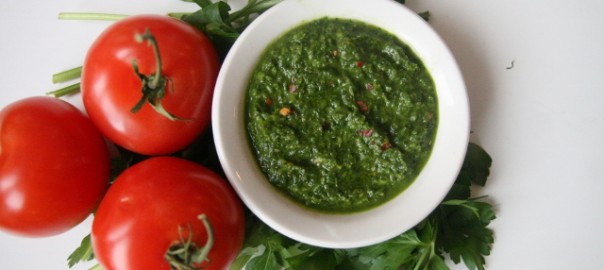“I’m using this sauce on everything!” my cookbook co-author Vicky Newman said,
we have to put it in our book!
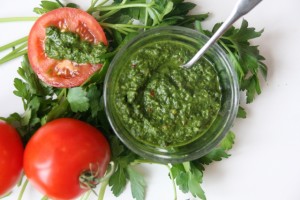 I gave Vicky’s chimichurri a try, and, like Vicky, was using it on a surprisingly wide variety of foods: eggs, grilled fish, lentils, vegetables, brown rice, as a sandwich spread . . .
I gave Vicky’s chimichurri a try, and, like Vicky, was using it on a surprisingly wide variety of foods: eggs, grilled fish, lentils, vegetables, brown rice, as a sandwich spread . . .
I was recently reminded of chimichurri when my brother returned from a fly-fishing trip in Argentina. He arrived with special spice packets provided by a chef who was making a chimichurri that guests loved . . . and put on just about everything.
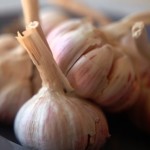 There are countless versions of the traditional Argentinean sauce, which is typically served over meat. Parsley (mostly fresh, sometimes dried), garlic, olive oil, hot peppers, and vinegar are common in most recipes. Some chimichurri “purists” don’t use cilantro – so if you’re not a cilantro fan, or don’t have any on hand, just double the parsley in this recipe. This version contains less olive oil than most recipes, so it is lighter and has fewer calories.
There are countless versions of the traditional Argentinean sauce, which is typically served over meat. Parsley (mostly fresh, sometimes dried), garlic, olive oil, hot peppers, and vinegar are common in most recipes. Some chimichurri “purists” don’t use cilantro – so if you’re not a cilantro fan, or don’t have any on hand, just double the parsley in this recipe. This version contains less olive oil than most recipes, so it is lighter and has fewer calories.
I love to cook with fresh herbs, and use them generously, since they dramatically enhance the flavour of almost any dish, perking up the taste of foods without relying on unnecessary fat or salt. Like most leafy greens, fresh herbs also have tremendous nutritional benefits. Having versatile chimichurri on hand makes adding fresh herbs to meals pretty easy.
Ingredients
- 2 garlic cloves, peeled
- 1 cup firmly packed fresh Italian parsley (flat leaf)*
- 1 cup firmly packed fresh cilantro
- 1/3 cup extra virgin olive oil
- 1/3 cup red wine vinegar or apple cider vinegar
- ¾ tsp. dried crushed red pepper
- ½ tsp. ground cumin
- ½ tsp. salt
* look for flat leaf or Italian parsley, which has a richer and more satisfying flavor than curly parsley
Directions
- Process garlic cloves in a food processor.
- Add the remaining ingredients, and process until ingredients are well chopped and combined.
Makes ONE CUP (or EIGHT 2-TBSP Servings)
Variations and Tips
- You’ll find great tips for preparing and storing fresh herbs here.
- Exact measurements aren’t necessary. If you want a sauce that is more pourable, add more olive oil or vinegar (olive oil will make it richer but also higher in calories; vinegar more acidic). Use more herbs for a thicker condiment that you can spread on sandwiches. You can tame or increase the spiciness by adding more or less red pepper flakes.
- Preparing parley and cilantro. There’s no need to meticulously tear the leaves from their stems since these stems are relatively tender and won’t be noticed once minced in the food processor. (For cilantro, I simply cut off the roots; remove thick stems from parsley or cilantro, but use the rest. I make a few rough cuts to the herbs, but let the food processor do everything else).
- Try lemon or lime juice instead of vinegar; and consider adding some zest from the citrus.
- Add other herbs – oregano is a popular chimichurri ingredient.
- If you prefer a chunkier sauce, chop the herbs by hand, or pulse in food processor instead of pureeing.
Nutrition Notes
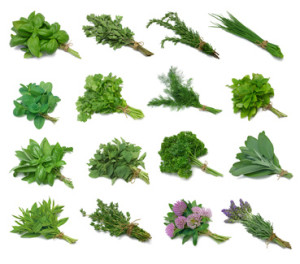 Health Benefits of Fresh Herbs.
Health Benefits of Fresh Herbs.
In addition to their seasoning qualities, fresh herbs offer health benefits. Researchers have identified a host of phytochemicals in culinary herbs that can help protect against disease.
Many fresh herbs are a concentrated source of antioxidants, compounds that help prevent damage to cells caused by free radicals. Preliminary research has revealed potential disease-protective properties of 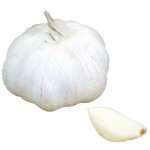 fresh herbs. For example, studies in laboratory animals have shown that compounds found in basil helped prevent cancerous changes; the volatile oil myristicin in parsley, inhibited tumor formation; and limonene, which is present in dill, helped shrink mammary tumors. Parsley and cilantro and rich sources of dietary nitrates, which might benefit blood pressure, heart health, and endurance performance.
fresh herbs. For example, studies in laboratory animals have shown that compounds found in basil helped prevent cancerous changes; the volatile oil myristicin in parsley, inhibited tumor formation; and limonene, which is present in dill, helped shrink mammary tumors. Parsley and cilantro and rich sources of dietary nitrates, which might benefit blood pressure, heart health, and endurance performance.
Garlic contains many protective compounds that are being studied for their disease-fighting effects.
Nutrition Per 2 Tbsp. Serving
- 90 calories
- <1 g protein
- 1 g carbohydrate
- 9 g fat (1 g sat)
- 0 mg cholesterol
- <1 g fiber
- 150 mg sodium
- 65 mg potassium
- 15 mg calcium
- 6 mg magnesium
Recipe adapted from Food for Thought: Healing Foods to Savor, by Sheila Kealey and Vicky Newman with Susan Faerber. California: Regents of the University of California, 2012.
Share This:
